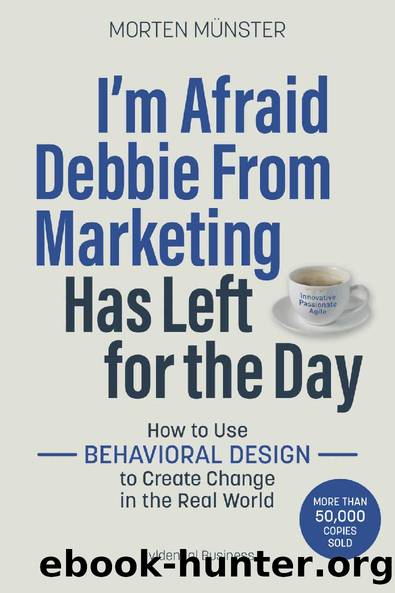I'm Afraid Debbie From Marketing Has Left for the Day: How to Use Behavioural Design to Create Change in the Real World by Morten Münster

Author:Morten Münster [Münster, Morten]
Language: eng
Format: epub, azw3
Tags: Salg og marketing
ISBN: 9788702292077
Publisher: Gyldendal Business
Published: 2019-06-12T00:00:00+00:00
Add Friction to the Unwanted Behaviour
Remove friction and you get more of the desired behaviour. By the same logic, if you add friction to the unwanted behaviour, you reduce it. Over the years, I’ve met hundreds of course participants through presentations, classes and training programmes on behavioural design. They always have funny examples of how they implement the theory back at the office. One executive assistant training to be a behavioural designer once gave a fantastic example of how she had translated the theory into a practical solution. At the law firm where she works, too many letters were sent as expensive first-class mail for no reason. This was a big expense. She wanted the lawyers to reflect on whether it was necessary to send so many letters first class. This had so far failed to get a response, because apparently lawyers do not consider such reflections to be part of the job description. So, the problem continued with “Dear All” e-mails, reminders, objections and minor conflicts. But this woman was not willing to give up so easily. Instead, she went out and studied the real world and the problem became clear. It was too easy to automatically send letters first-class, because trays for firstclass letters were placed in all the copy rooms where letters were often printed out. That’s perfect behavioural design if you want to send more first-class letters, but a terrible set-up if you want to reduce postage expenses. Her solution was to add a touch of friction. The trays were moved to reception area. Now the architecture itself was adding natural friction. If sending the letter immediately is important, of course you would walk the extra 100 metres, but if not, you think twice about the extra effort. This is what she wrote:
“Hi Morten. I know you have a weakness for measurable follow-up on initiatives that regulate behaviour, so I thought you shouldn’t miss out on the results when [client] removed all the first-class post trays from the copy rooms so first-class letters could only be sent from the reception desk. The figures are (drum roll!): In the first 6 months, this initiative has meant that 3,347 first-class letters were sent compared with 13,366 in 2015, and 5,408 second-class letters were sent compared with 1,342 in 2015. That’s quite a treat for behavioural designers :o)”
She’s right. A real treat. In the space of six months, moving a post tray 100 metres resulted in lawyers sending 10,000 fewer letters by first class. It’s always tempting to sneer at examples like this and say that it’s just mail and our problems are much more difficult and refined. But in our experience, the reverse is true. Remember the divorces. Frictions, good and bad, is the answer. The tougher and more complex the problem you’re facing, the more important it is that you rely on the idea behind the path of least resistance. The concept of making something more difficult and uncomfortable has become a design discipline that behavioural designers frequently turn to as a source of inspiration.
Download
I'm Afraid Debbie From Marketing Has Left for the Day: How to Use Behavioural Design to Create Change in the Real World by Morten Münster.azw3
This site does not store any files on its server. We only index and link to content provided by other sites. Please contact the content providers to delete copyright contents if any and email us, we'll remove relevant links or contents immediately.
| Direct | Global |
| Industrial | Multilevel |
| Product Management | Research |
| Telemarketing | Web Marketing |
Influence: The Psychology of Persuasion by Robert B. Cialdini(4178)
The Miracle Morning by Hal Elrod(3909)
The Hacking of the American Mind by Robert H. Lustig(3579)
Pre-Suasion: A Revolutionary Way to Influence and Persuade by Robert Cialdini(3413)
Unlabel: Selling You Without Selling Out by Marc Ecko(2981)
Hidden Persuasion: 33 psychological influence techniques in advertising by Marc Andrews & Matthijs van Leeuwen & Rick van Baaren(2778)
Who Can You Trust? by Rachel Botsman(2732)
Kick Ass in College: Highest Rated "How to Study in College" Book | 77 Ninja Study Skills Tips and Career Strategies | Motivational for College Students: A Guerrilla Guide to College Success by Fox Gunnar(2720)
Purple Cow by Seth Godin(2698)
Ogilvy on Advertising by David Ogilvy(2682)
I Live in the Future & Here's How It Works by Nick Bilton(2524)
This Is Marketing by Seth Godin(2482)
The Marketing Plan Handbook: Develop Big-Picture Marketing Plans for Pennies on the Dollar by Robert W. Bly(2413)
The Power of Broke by Daymond John(2376)
Building a StoryBrand by Donald Miller(2360)
The 46 Rules of Genius: An Innovator's Guide to Creativity (Voices That Matter) by Marty Neumeier(2310)
Draw to Win: A Crash Course on How to Lead, Sell, and Innovate With Your Visual Mind by Dan Roam(2277)
The Tipping Point by Malcolm Gladwell(2204)
Market Wizards by Jack D. Schwager(2163)
